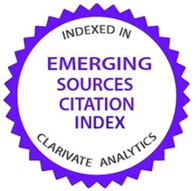¿Mensagens de texto sexuais ou pedofilia?
DOI:
https://doi.org/10.47741/17943108.190Palavras-chave:
vidas digitais, pedofilia, pornografia, pessoa que envia mensagens de texto sexuais, redes SNSResumo
O mundo acadêmico está debatendo seriamente a necessidade crítica de estatutos legais para diferenciar entre as imagens sexuais que os adolescentes e os adultos jóvens críam para compartilhar entre eles e a pornografia cibernética desenvolvida pelos pedófilos para molestar e explotar as crianças. Esse documento, baseado principalmente na análise secundária, inclui a pesquisa empírica realizada em 13 oficiais da polícia, 20 adolescentes, e 20 pais dos adolescentes. Revela a gravidade da situação e enfatiza a exigência por uma resposta legal imediata e apropriada.
Downloads
Referências
Benotsch, E. G., Snipes, D. J., Martin, A. M., & Bull, S. S. (2013). Sexting, substance use, and sexual risk behavior in young adults. Journal of Adolescent Health, 52 (3), 307-313.
Bowker, A., & Sullivan, M. (2010). Sexting: risky actions and overreactions. FBI Law Enforcement Bulletin, 79 (7), 27-31.
Brunker, M. (2009). 'Sexting', surprise: teens face child porn charges. MSNBC: http://www.msnbc.msn.com/id/28679588/.
Burns, K. (1997). Reviewed work. Wired women: gender and new realities in cyberspace by Lynn Cherny; Elizabeth Reba Weise, and Nattering on the Net: Women, Power and Cyberspace by Dale Spender. NWSA Journal, 9 (2), 195-197.
Caron, C. (2011). Teen Sexting Linked to Psychological Distress. Retrieved from ABC news: http://abcnews.go.com/Technology/teen-sexting-linked-psychological-distress/story?id=14914700#.UXeD68rosf4.
Casey, D. C. (2012) .Sexting on the rise among teenagers; experts seek ways to prevent harm. Retrieved from the Post and Courier: http://www.postandcourier.com/article/20121007/PC16/121009395/-sexting-on-the-rise-amongteens-experts-seek-ways-to-prevent-harm.
Davis, C. (2013). Sexting among teenagers. Undergraduate research paper, Auburn University at Montgomery, AL (Unpublished).
Dowdell, E. B., Burgess, A. W., & Flores, J. R. (2011). Online social networking patterns among adolescents, young adults, and sexual offenders. American Journal of Nursing, 111 (7), 28- 36.
Drouin, M., & Landgraff, C. (2012). Texting, sexting, and attachment in college students' romantic relationships. Computers in Human Behavior, 28, 445-447. Indiana University-Purdue University Fort Wayne, United States.
Eraker, E. C. (2010). Stemming sexting: sensible legal approaches to Teenagers, exchange of self-produced pornography. Berkeley Technology Law Journal, 25 (1), 555-596.
Gordon-Messer, D., Bauermeister, J., Grodzinski, S., & Zimmerman, M. (2013). Sexting among young adults. Journal of Adolescent Health, 52 (3), 301-306.
Harmon, J. (2010). Sexting. Graduate research paper. Minot State University, Minot, ND (Unpublished).
Harrison, M. A., & Gilmore, A. L. (2012). U txt WHEN? College students' social contexts of Text Messaging. The Social Science Journal. Retrieved from: http://dx.doi.org/10.1016/.soscij. 2012.05.003.
Henderson, L., & Morgan, E. (2011). Sexting and sexual relationships among teens and young adults. McNair Scholars Research Journal, 7 (1), 31-39.
Haynes, A. M. (2012). The age of consent: when is sexting no longer "speech integral to criminal conduct"? Cornell Law Review, 97, 369-404.
Hudson, H. K. (2011). Factors Affecting Sexting Behaviors. ProQuest, UMI Dissertation Publishing.
Juvenile, J. (2013). Teen sexting case goes to trial in Fairfax County. Retrieved from The Washington Post: http://articles.washingtonpost.com/2013-04-17/local/38616662_1_sexting-cases-videos.
Kaur, P. (2012). Sexting: perceptions and practices among college students. Presented in Annual Conference of American Society of Criminology, in the year of 2012.
Lindsay, M., & Krysik, J. (2012). Online harassment among college students. Information, Communication & Society, 15 (5), 706-707.
Lounsbury, K., Mitchell, K. J., & Finkelhor, D. (2011). The true prevalence of 'sexting'. Crimes against Children Research Center. Retrieved from: http://www.unh.edu/ccrc/pdf/sexting%20fact%20sheet%204_29_11.pdf.
Margaryan, A., Littlejohn, A., & Vojt, G. (2011). Are digital natives a myth or reality? University students' use of digital technologies. Computers & Education, 56 (2), 429-440. Elsevier.
Marks, A. (2009). Charges Against 'Sexting' Teenagers Highlights Legal Gaps, CHRISTIAN Sci. Mon., Mar. 30, 2009, http://features.csmonitor.com/innovation/2009/03/30/charges-against-sexting-teenagers-highlight-legal-gaps/.
Mohan, G. (2013). Sexting prevalent among minority teens. Retrieved from Los Angeles Times: http://articles.latimes.com/2013/mar/01/news/la-heb-sexting-20130228.
National Center for Missing & Exploited Children, "Policy Statement on Sexting." Last modified September 21, 2009. http://www.missingkids.com/missingkids/servlet/NewsEventServlet?LanguageCountry=en_US&PageId=4130.
Ostrager, B. (2010). Note, SMS. OMG! LOL! TTYL: translating the law to accommodate today's teens and the evolution from texting to sexting. Family and Conciliation Courts Review, 48 (4), 712-726.
Pew Research Center. "Teens and Sexting: How and Why Minor Teens are Sending Sexually Suggestive Nude or Nearly Nude Images via Text." Last modified December 15, 2009. http://pewresearch.org/assets/pdf/teens-andsexting.pdf.
Ross, M. W. (2005). Typing, doing, and being: sexuality and the Internet. Journal of Sex Research, 42 (4), 342-352.
Saltman, J. (2012). B.C. boy who posted video of alleged gang rape sentenced to probation. National Post, February 10, 2012, http://news.natonalpost.com/2012/02/10/b-c-teen-getsprobation-for-sharing-video-photos-of-alleged-rave-rape/.
Stone, N. (2011). The 'sexting' quagmire: criminal justice responses to adolescents' electronic transmission of indecent images in the UK and the USA. Youth Justice, 11 (3), 266-281.
Strassberg, D., & McKinnon, R. (2012). Sexting by high school students: an exploratory and descriptive Study. Archives of Sexual Behavior, 42 (1), 15-21.
The National Campaign to Prevent Teen and Unplanned Pregnancy: Sex and Tech, Results from a Survey of Teens and Young Adults 1 (Dec. 2008), http://www.thenationalcampaign.org/sextech/PDF/SexTech_Summary.pdf.
U.S. Teen Mobile Report (2010): Calling Yesterday, Texting Today, Using Apps Tomorrow, Nielsen wire.
US Department of Justice (2012). Citizen's Guide to U.S. Federal Law on Child Pornography. Retrieved from: http://www.justice.gov/criminal/ceos/citizensguide/citizensguide_porn.html.
Waskul, D. D. (2004). Net.SeXXX: Reading on Sex, Pornography, and the Internet. Peter Lang Publishing Incorporated.
Weisskirch, R. S., & Delevi, R. (2011). 'Sexting' and adult romantic attachment. Computers in Human Behavior, 27 (5), 1697-1701.
Wolak, J., & Finkelhor, D. (2011). Sexting: a typology. University of New Hampshire: Crimes against Children Research Center. Retrieved from: http://www.unh.edu//ccrc/pdf/CV231_Sexting%20Typology%20Bulletin_4-4-11_revised.pdf.
Wysocki, D., & Childers, C. (2011). Let my fingers do the talking: sexting and infidelity in cyberspace. Sexuality and Culture, 15 (3), 217-239.
Zhang, X. (2010). Charging Children with child pornography - Using the legal system to handle the problem of 'sexting'. Computer Law and Security Review 26 (251-259).
Downloads
Publicado
Edição
Seção
Licença
Licencia creative commons CC BY NC ND https://creativecommons.org/licenses/by-nc-nd/2.0/





















